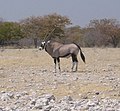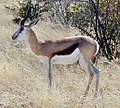Adventist Youth Honors Answer Book/Nature/Antelopes
| Antelopes | ||
|---|---|---|
| Nature East Africa Division See also Antelopes - Advanced |
Skill Level 1 | 
|
| Year of Introduction: Unknown | ||
1. Give the general characteristics of antelopes.
[edit | edit source]Antelopes are a group of herbivorous African and Asian animals, distinguished by a pair of hollow horns on their heads. Many are more closely related to cows or goats than to each other. There are many different species of antelope, ranging in size from the tiny royal antelope to the giant eland. They typically have a light, elegant figure, are slender, have graceful limbs, small cloven hoofs and a short tail. Antelopes have powerful hindquarters and, when startled, run with a peculiar bounding stride that makes them look as though they are bouncing over the terrain like a giant rabbit. Some species of antelope can reach speeds of 50 miles (80 kilometers) per hour, making them among the fastest of land animals.
2. Give three size-groups of these animals, with two examples of each
[edit | edit source]- Small Antelopes
- Duiker, Klipspringer, and Dik-dik
- Medium Antelopes
- Bushbuck, Impala, and Springbok
- Large Antelopes
- Wildebeest and Elands
3. Be able to identify at least 15 different antelopes.
[edit | edit source]-
Addax
-
Bongo
-
Bontebok
-
Dik-dik
-
Duiker
-
Eland
-
Gemsbok
-
Hartebeest
-
Impala
-
Klipspringer
-
Nyala
-
Oribi
-
Sable Antelope
-
Springbok
-
Thompson's Gazelle
-
Wildebeest
4. What do they eat? How do they digest their food?
[edit | edit source]Antelopes are ruminants. Like other ruminants, such as cattle and sheep, they have well-developed cheek teeth or molars, which grind cud into a pulp. They have no upper incisors; in order to tear grass stems and leaves, their lower incisors press against a hard upper gum pad when they bite.
5. Name three ways in which one benefits from having these animals in the country where one lives.
[edit | edit source]- 1. They are beautiful
- Antelopes are beautiful to behold. They are graceful and fast. An eland, from a standing-position, can jump over 8 feet high, making them difficult to fence in.
- 2. They attract tourists
- Because antelopes are such beautiful creatures, tourists flock to countries so that they can see them. They also provide food for large predators, and large predators also attract tourists. Tourism forms the basis of many economies.
- 3. They provide meat
- As they are much more common than carnivores, they can provide protein-rich and lean meat.
6. What are “false hoofs?” Which members of this family do not have them?
[edit | edit source]False hooves are the toes on an animal which do not normally touch the ground. These toes are present on what one would normally consider an antelope's ankle. Other animals (such as dogs) also have toes like this, only they are called dewclaws rather than false hooves (since dogs don't have hooves).
Sharpe's grysbok and steenbok both lack false hooves.
7. Which antelopes are classed as rare South African animals now? Where can they be seen, outside of the zoo and the museum?
[edit | edit source]- Giant Sable Antelope
- This animal was thought to be extinct, but was recently rediscovered. It is found in Angola (which should be considered Southern Africa rather than South Africa).
- Tsessebe
- This animal is another rare South African antelope found in the Kruger National Park.
- Roan Antelope
- Like the Tsessebe, this antelope is also extremely rare and found in the Kruger National Park.
8. What natural enemies do the antelopes have? How do antelopes protect themselves and their young?
[edit | edit source]Big cats (cheetahs, lions, and leopards) are the antelope's most formidable natural enemies. Antelopes are fast runners, although they are not the fastest animals in the world. They are good at quick, precise turns, and they can run very fast for extended periods of time. This gives them an advantage over many predators such as the cheetah, which relies on sprinting and can be tired out by the antelope's greater stamina. Newborn calves can run with the herd immediately after birth.
The antelope's choice to flee is based largely on the type of predator and its distance from the herd. Usually, gazelles will permit lions to come within 200 m (650 ft.) before fleeing. They likely recognize that a hunting lion prefers to hide while stalking its prey, meaning a visible lion is unlikely to attack. Cheetahs, who are superb sprinters, pose a more dangerous threat. Gazelles will flee from cheetahs when they are over 800 m (0.5 mi.) away.
Antelopes communicate with each other using a varied array of sounds. For example, dik-diks whistle when alarmed, warning other animals of danger as well. This characteristic makes dik-diks less favorable prey for hunters. Generally, though, sight is a much more common form of communication than sound among antelopes. An antelope's mood is indicated by its posture and movement. When excited or alarmed, most medium-sized species of antelope bounce up and down on all four legs, keeping them stretched out straight. This behavior, known as pronking or stotting, acts as an alarming display. Some biologists theorize that stotting also sends a message to predators, showing that individual antelopes are fit and alert, and therefore not worth pursuing.
9. Which is
[edit | edit source]a. The largest antelope?
[edit | edit source]The Eland is the largest antelope.
b. The swiftest runner?
[edit | edit source]Although the Topi has the reputation of being the fastest of all antelopes, its top speed is only 50 km/h. The Topi is a subspecies of the Tsessebe that can run between 50-80 km/h. The wildebeest and the Thomson's gazelle on the other hand can run 80 km/h.
c. A good fighter?
[edit | edit source]The sable antelope is a very aggressive animal, and they often fight among themselves. Because they are such good fighters, even lions are wary of attacking them. Roan antelopes are also formidable fighters.
d. A good jumper?
[edit | edit source]The impala and springbok can jump 10 meters![]() in a single bound.
Also, the springbok jumps high, achieving vertical heights up to 4 meters
in a single bound.
Also, the springbok jumps high, achieving vertical heights up to 4 meters![]() .
.
e. Chiefly nocturnal?
[edit | edit source]The duiker, dik-dik, and the bushbuck are chiefly nocturnal.
f. Called “the African Chamois?"
[edit | edit source]The Klipspringer is sometimes called the "African Chamois."
g. The national animal of the Union of South Africa?
[edit | edit source]The national animal of the Union of South Africa is the Springbok.
10. Say which antelope you like to watch most. Tell five of its habits.
[edit | edit source]Here are the characteristics of several antelope. Your Pathfinders may already have a favorite (or choose some other) antelope not listed here, and that is fine. Encourage research.
- Dik-dik
- These antelopes are monogamous, meaning they mate for life.
- Female dik-diks are somewhat larger than males.
- The males have horns, which are small, and slanted backwards.
- They are named for the sound they make when alarmed.
- They are small.
- Bongo
- Bongos have a striking reddish coat
- They have black and white markings
- They have long slightly spiral horns.
- They are large
- Some say it is the most beautiful antelope.
- Thomson's Gazelle
- "Tommies" are known as swift animals.
- They are able to run at high speeds for long periods of time.
- They exhibit a distinctive behavior of stotting (running slowly and jumping high before fleeing) when they are threatened by predators such as lions or cheetahs.
- They live and migrate in herds with hundreds or thousands of other Thomson's gazelles.
- Occasionally, a Thomson's gazelle and a zebra will even appear to enjoy one another's company with great sociability.
- Impala
- They are reddish-brown in color with lighter flanks, and have white underbellies.
- Males have lyre-shaped horns which can reach up to 90 centimetres (3 ft) in length.
- Impala are among the most beautiful and graceful of the antelopes.
- Exceedingly agile, they are capable of leaping more than 12 m in a single bound.
- Young male impala form bachelor herds of around thirty individuals.
- Females and young form herds of up to two hundred individuals.
- Mature males hold territories, and lead any female herds that wander into their territory.
- Klipspringer
- Their name means rock hopper.
- They reach approximately 58 cm (22 inches) at the shoulder.
- Klipspringers are relatively small animals compared to some of their larger antelope cousins.
- They never need to drink, since the plants they eat provide them with enough water to survive.
- Only the males have fragile horns that are usually about 20–25 cm (4-6 inches) long.
- They stand on the tips of their hooves.
- Roan Antelope
- Roan Antelope stand about a meter and half at the shoulder and weigh around 250 kilograms.
- Roan Antelope are a roan color with a lighter underbelly, white eyebrows and cheeks and a black face, lighter in females.
- There is a short erect mane, a very light beard and prominent red nostrils.
- The horns are ringed and can reach a meter long in males, slightly shorter in females.
- The horns arch backwards slightly.
- Roan Antelope are found in grasslands where they eat mid-length grass.
- Roan Antelope commonly fight among themselves for dominance of their herd, brandishing their horns while both animals are on their knees.
- Springbok
- Sprinboks have a pocket-like skin flap which extends along the middle of the back on to the tail. The springbok can lift this flap, which makes the white hairs underneath stand up in a conspicuous 'fan'.
- Like the Thomson's gazelle, springboks stotter when threatened.
- They used to be very common, but numbers have recently diminished due to an increase in hunting and more land being fenced off as farm land.
- They are a small brown and white gazelle that stand about 80 cm (32 in) high.
- Springboks inhabit the dry inland areas of south and southwestern Africa.
- Wildebeest
- Wildebeests are also known as gnus.
- They grow to 1.15–1.4 meters (45–55 inches) at the shoulder.
- They weigh between 150 and 250 kilograms. (330 and 550 pounds).
- They inhabit the plains and open woodlands of Africa, especially the Serengeti.
- Wildebeest can live for more than 20 years.
- They migrate in May, when around 1.5 million animals move from the plains to the woods
- They return in November as summer rains water the plains.
References
[edit | edit source]- Wikipedia articles on Antelope, Dik-dik, Sable antelope, Eland, and others.
- http://www.sanparks.org/about/media/2004/rareantelopeconf.php
- Book:Adventist Youth Honors Answer Book/Honors with an Advanced Option
- Book:Adventist Youth Honors Answer Book/Honors
- Book:Adventist Youth Honors Answer Book
- Book:Adventist Youth Honors Answer Book/Skill Level 1
- Book:Adventist Youth Honors Answer Book/Honors Introduced in Unknown
- Book:Adventist Youth Honors Answer Book/Nature
- Book:Adventist Youth Honors Answer Book/East Africa Division
- Book:Adventist Youth Honors Answer Book/Completed Honors
















